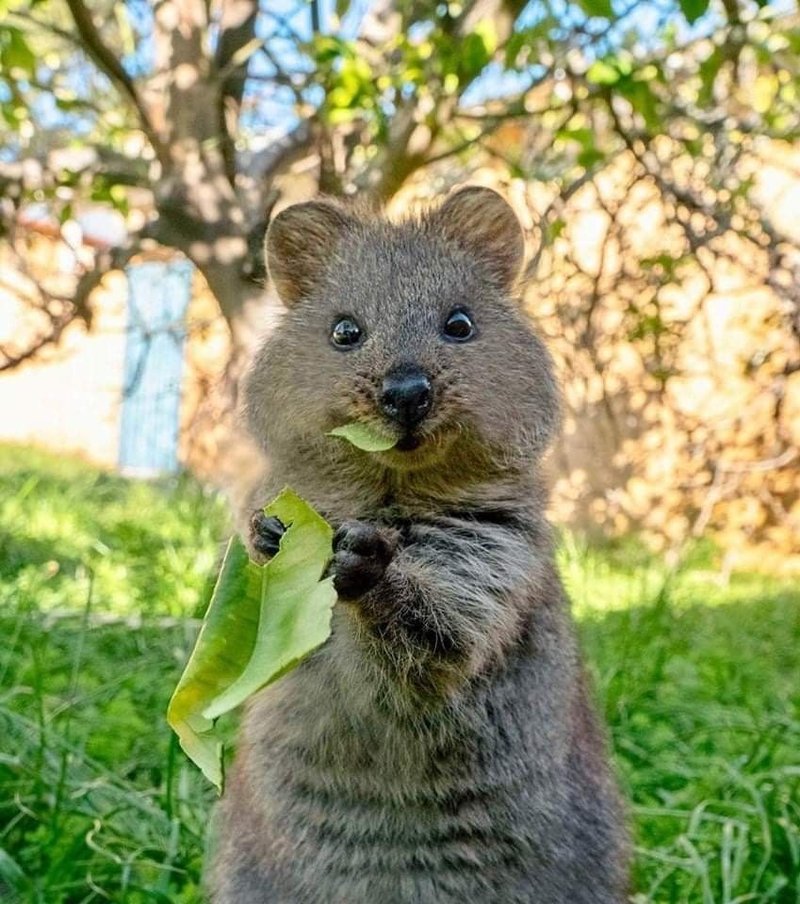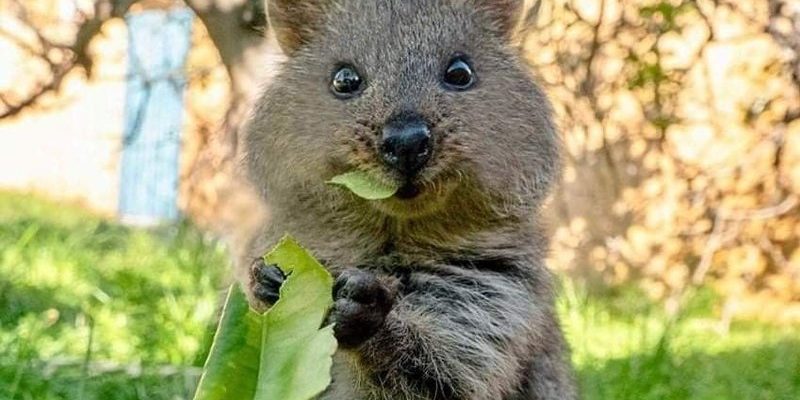
You might be wondering what features make quokkas so special—and how can you spot those similarities in other species? Think of it like spotting friends in a crowd: they might have different styles or quirks, but you can still see the connections. Each of the animals we’ll look at has a unique charm, but they also share some characteristics that remind us of the delightful quokka. So, grab a cup of coffee, and let’s dive in!
The Wallaby: Quokka’s Larger Cousin
When talking about animals similar to the quokka, it’s hard not to mention the wallaby. These hopping marsupials belong to the same family as the quokka and share many delightful traits. Wallabies are generally larger than quokkas but have that same compact body shape, strong hind legs, and a fascinating tail used for balance.
Although they come in various species, one thing that stands out is their social nature. Just like quokkas, wallabies can often be seen in groups, hopping around and interacting with one another. If you’re trying to tell them apart, keep an eye on size and features. Quokkas have a more rounded face and smaller ears, while wallabies sport longer limbs and a more elongated snout.
Why They Matter
Wallabies play a vital role in their ecosystem by helping with plant seed dispersal. Their feeding habits can aid in the growth of various plant species. If you love learning about animal behavior, watching wallabies interact in their natural habitat can be a rewarding experience. They often communicate through body language, making it a treat to observe their social dynamics.
The European Rabbit: A Familiar Face
Next up, let’s hop over to the European rabbit. Known for their long ears and fluffy tails, rabbits share a few similarities with quokkas, especially in size and social behavior. Both animals tend to thrive in community settings, preferring the company of their kind. However, while quokkas are nocturnal, rabbits are crepuscular, meaning they are most active during dawn and dusk.
One of the easiest ways to tell them apart is by looking at their ears. Quokkas have small, rounded ears, while European rabbits boast long, upright ears. If you’ve ever seen a quokka up close, you’ll also notice they’re more stocky with a chubbier face compared to the sleeker rabbit.
Why They Matter
European rabbits have had a significant impact on agriculture and ecosystems, often seen as both beloved pets and, unfortunately, pests. Their burrowing habits can change landscapes, which can be a double-edged sword for farmers and natural habitats alike.
The Capybara: The World’s Largest Rodent
The capybara might seem like a stretch, but hear me out! This gentle giant is the largest rodent and has a relaxed, social nature similar to quokkas. Capybaras often hang out in groups near water bodies, much like quokkas find comfort in their native scrublands.
While their size is the most significant giveaway, you can also notice differences in their fur texture. Quokkas have a softer coat, while capybaras exhibit a coarser, waterproof covering. Spotting a capybara lounging in the water surrounded by its friends can be just as charming as seeing a quokka in its natural habitat.
Why They Matter
As friendly creatures, capybaras have a unique social role in their ecosystem, often cohabitating with other species. They help in controlling aquatic plants and provide food for various predators, creating a balanced ecosystem. Plus, they’re just fun to watch!
The Pademelon: Small and Adorable
Let’s give a nod to the pademelon, another adorable marsupial cousin of the quokka. These small wallabies prefer dense forests and are often found in similar habitats. Although they’re smaller, pademelons have that same round body shape and cheerful disposition.
You can spot a pademelon by their distinctively shorter legs and broader body than a quokka. They have a more pronounced snout, which can be a fun detail to notice. Just like quokkas, they enjoy nibbling on grasses, fruits, and leaves, making them a delight to observe in the wild.
Why They Matter
Pademelons play an essential role in their environment, helping control plant growth and providing food for predators. Their presence indicates a healthy, balanced ecosystem, so spotting them can be quite an outdoor win!
The Sugar Glider: A Cute, Flying Marsupial
Now, let’s glide over to the sugar glider. This tiny, nocturnal marsupial might not look like a quokka at first glance, but their playful nature and social instincts are very similar. Sugar gliders can be found in the same regions as quokkas and tend to live in family groups, making them social little creatures.
When it comes to distinguishing them, look at their larger eyes that help them navigate the night sky and their gliding membranes that allow them to soar from tree to tree. Their small size and fluffy tails may remind you of a quokka, though they vary in color and have a more pronounced face.
Why They Matter
Sugar gliders contribute to the ecosystem by pollinating flowers and aiding in seed dispersion. They not only look cute, but they serve a crucial role in maintaining the balance of their forested habitats.
The Mongoose: Agile and Curious
Though not a marsupial, the mongoose shares some quirky traits with the quokka. These agile little critters are known for their playful antics and social behavior. They often live in groups, much like quokkas, which makes them entertaining to watch.
To tell them apart, focus on their body shape and fur. Mongooses have longer bodies and shorter legs, giving them a more elongated appearance compared to a quokka. Their fur can vary in color and texture, making them quite distinct despite their similarities in social behavior.
Why They Matter
Mongooses are fascinating because they play a significant role in controlling pests. They often hunt snakes and rodents, helping maintain a balance in the ecosystem that can benefit agriculture and human activities. Plus, their intelligence is truly remarkable.
The Tasmanian Devil: A Unique Spin
Let’s not forget about the Tasmanian devil. While they may look a bit more intimidating than a quokka, they share some characteristics, especially in social behavior. These carnivorous marsupials are known for their feisty nature and their vocalizations, much like the playful calls of quokkas.
When it comes to distinguishing them, the Tasmanian devil is larger, with a more muscular build and a dark coat featuring white markings. While quokkas are herbivorous, Tasmanian devils feast on meat, making their dietary needs vastly different.
Why They Matter
Tasmanian devils are crucial to their ecosystem as scavengers. By feeding on dead animals, they help keep their environment clean and healthy, showcasing the importance of each species in maintaining ecological balance.
The Ringtail Possum: A Charming Climber
Another delightful marsupial to consider is the ringtail possum. These little critters have a similar body shape to quokkas, but they stand out thanks to their long, prehensile tails that help them climb. Ringtail possums are also nocturnal and social, often seen snuggling together in trees.
To differentiate them from quokkas, check out their bushy tail and the fact that they have larger eyes. Their fur is often softer and can come in a variety of shades, but they generally have that endearing charm that makes you want to say “aww.”
Why They Matter
Ringtail possums play a key role in their ecosystem by helping with seed dispersion and pollination. Their presence can indicate a healthy forest, and watching them navigate trees can be quite captivating.
The Marmoset: Tiny and Social
Finally, let’s look at the marmoset. These tiny primates, native to South America, are known for their sociable nature and playful behavior. Marmosets, like quokkas, often live in groups and enjoy interacting with one another.
Spotting the differences is easy; marmosets have longer limbs and a more pronounced vocal range. Their fur can vary widely, often sporting striking patterns. They may not hop around like quokkas, but their antics can provide just as much entertainment!
Why They Matter
Marmosets are vital for their ecosystems, aiding in seed dispersal. They also serve as prey for larger animals, which helps maintain the food chain. Observing their social interactions can be a heartwarming experience, leaving you with a smile much like a quokka does.
In wrapping up our exploration of animals similar to the quokka, it’s clear that while each has its unique features, there’s a shared charm that draws us in. From the social wallaby to the playful marmoset, these creatures all contribute to the beauty of our world in their own delightful ways. Understanding these similarities not only enriches our appreciation of biodiversity but also highlights the importance of conservation efforts.
So next time you see a quokka or one of its charming relatives, remember the little quirks that make each species special. Whether it’s their social behavior, habitat preferences, or physical traits, there’s always something new to learn and admire. Happy exploring!

